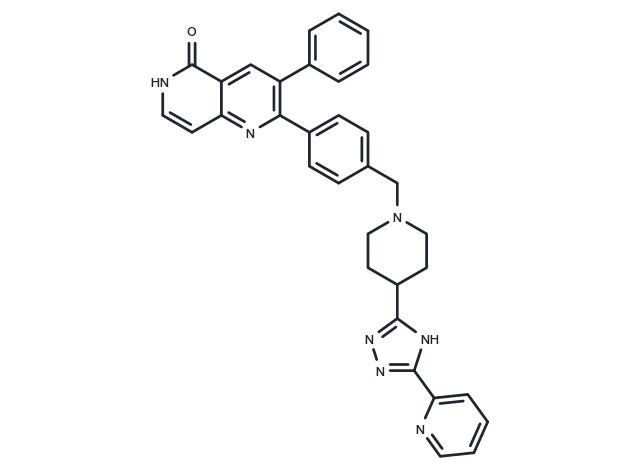Powder: -20°C for 3 years | In solvent: -80°C for 1 year


Akt1 and Akt2-IN-1 is an allosteric inhibitor of Akt1 (IC50=3.5 nM) and Akt2 (IC50=42 nM). It has potent and balanced activity.

| Pack Size | Availability | Price/USD | Quantity |
|---|---|---|---|
| 5 mg | 6-8 weeks | $ 347.00 | |
| 25 mg | 6-8 weeks | $ 1,140.00 | |
| 50 mg | 6-8 weeks | $ 1,490.00 | |
| 100 mg | 6-8 weeks | $ 1,990.00 | |
| 1 mL * 10 mM (in DMSO) | 6-8 weeks | $ 413.00 |
| Description | Akt1 and Akt2-IN-1 is an allosteric inhibitor of Akt1 (IC50=3.5 nM) and Akt2 (IC50=42 nM). It has potent and balanced activity. |
| Targets&IC50 | Akt2:42 nM, Akt1:3.5 nM |
| In vitro | Akt1 and Akt2-IN-1 (Compound 17) has moderate activity in an hERG binding assay (IC50=5610 nM) and is a substrate for human P-glycoprotein[1]. Consistent with the allosteric mode of inhibition, Akt1 and Akt2-IN-1 (Compound 17) is dependent on the PH-domain for Akt inhibition. Akt1 and Akt2-IN-1 (Compound 17) is selective for Akt1/2 over Akt3 (IC50=1900 nM), and is highly selective over other members of the AGC family of kinases (>50 μM vs PKA, PKC, SGK). |
| In vivo | Akt1 and Akt2-IN-1 (Compound 17) is well tolerated in at exposures that provide high levels of Akt1 and 2 inhibition in vivo. Akt1 and Akt2-IN-1 (Compound 17) shows good pharmacokinetics in rat with a low clearance of 4.6 mL/min/kg and a half-life of 3.8 h. Due to the improved cell potency, physical properties, and rodent pharmacokinetics of Akt1 and Akt2-IN-1 (Compound 17), tolerability and Akt inhibition are assessed in mice. Akt1 and Akt2-IN-1 (Compound 17) has also been shown to inhibit the growth of A2780 tumors in vivo when used as monotherapy and has potent inhibitory activity against Akt1 and 2 in vivo in a mouse lung and efficacy in a tumor xenograft model. Using an acute dosing schedule (IP dosing of 50 mg/kg at times 0, 3, and 8 h), administration of Akt1 and Akt2-IN-1 (Compound 17) is well tolerated in mice and shows high levels of Akt inhibition in mouse lung[1]. |
| Molecular Weight | 539.63 |
| Formula | C33H29N7O |
| CAS No. | 893422-47-4 |
Powder: -20°C for 3 years | In solvent: -80°C for 1 year
DMSO: 35 mg/mL (64.86 mM)
You can also refer to dose conversion for different animals. More
bottom
Please see Inhibitor Handling Instructions for more frequently ask questions. Topics include: how to prepare stock solutions, how to store products, and cautions on cell-based assays & animal experiments, etc.
Akt1 and Akt2-IN-1 893422-47-4 Cytoskeletal Signaling PI3K/Akt/mTOR signaling Akt Akt-1 and Akt2-IN-1 Akt1 and Akt2IN1 Akt1 and Akt2 IN 1 inhibitor inhibit
